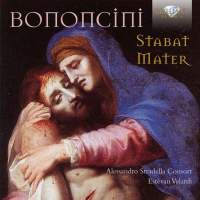Texte paru dans: / Appeared in: |
|
|
Outil de traduction ~ (Très approximatif) |
|
|
Reviewer: Bertil
van Boer The quintessential Stabat mater for the 18th century is the one composed by Giovanni Pergolesi, and it is so well represented in the discography that one might note that it dominates whatever market there is for such a moving and often lugubrious genre. That is, however, not to say that Pergolesi was the only one to write moving and emotionally gripping music for the weeping of the Virgin Mary at the cross of her crucified son. This disc resurrects an equally emotional work by Antonio Maria Bononcini, maestro di cappella at the Este court in Modena and brother to Handel’s chief rival. Few have probably heard of his sacred works, for the bulk remained unpublished, as the famed Padre Martini noted. This is a pity, if this disc is any indication, for Bononcini was fully capable in writing music that is finely tuned and highly introspective.
This work has a quartet of soloists, along with a brief chorus (here two on a part) that supports the extensive solo work. The music is solemn, yet moves with a languid grace. For example, the duet Quis est homo has both alto and soprano weaving in and out of each other’s lines, sometimes in counterpoint and others with close suspensions above the light tread of a ghostly continuo. This is fully the equivalent of Pergolesi, though stylistically it belongs to the previous generation. The following Pro peccatis begins in stately chorale-like procession with the voices entering in imitation, with the texture thickening as the movement develops. It is not exactly the older style, but rather an imitation; the strings are relegated to the occasional brief ritornello, even as they double the voices in the majority of the movement. This contrasts with the Juxta crucem with its strong and virile bass solo, at once unctuous and then soothing above the traditional walking bass. The tenor solo aria Fac ut portem is more modern in style, sounding operatic with a more insistent rhythm and wider range of coloratura. The invocation of the choral Fac me plagis with dotted rhythmic string accompaniment punctuating the homophonic vocal statements, leading directly to the operatic Inflammatus with its alternating solo and choral verses, during which the strings have a rapid bit of passagework that seems like the glistening of flames. The Quando corpus is slow and mysterious, serving as an introduction to the gnarly Paradisi Gloria fugue. All in all, this is a solemn and lovely work, and if it is representative of the genre, then one has much to learn apart from the iconic Pergolesi work.
Since the Stabat mater is too short for a complete disc, Brilliant Classics has chosen to pair it with a brief Marian cantata, Dio e la vergine, for a pair of soloists who outline the characters Dio (God) and the Virgin. Here one has a dialogue in traditional cantata format, three recitatives, with an aria apiece for each character and a concluding duet. The first aria for Dio is quite operatic, with an extensive violin introduction and the bass solo pretty much following the continuo. The rhythmic structure is quite dance-like, almost a flowing line that is soothing and quiet. The aria of the Virgin, in contrast, is more insistent, with the dotted rhythms forcing a sense of urgency in the strings, while the voice part is quite lyrical. The duet, Sei tutta bella, blends both of these styles, first in dialogue fashion and concluding with some rather intricate counterpoint. The performance of the Stradella Consort is quite fine. Soprano Silvia Piccollo and alto Claudia Clarich both have nicely resonant voices with a full tone, yet never overbearing for the delicate lines Bononcini writes. Bass Marco Perrella is suitably full and rounded, with a good sense of expressiveness, while tenor Giampiero de Paoli is lighter and more fluid. In the cantata, Daniela Aimale has a softer lyrical style, which combines nicely with bass Giovanni Dagnino. The playing of the consort is nicely nuanced, never overshadowing the delicate vocal lines, but providing flashes of instrumental color when needed. I find the tempos work extremely well here and the double quartet that functions as the chorus sounds larger than it is, providing the sort of contrast needed for Bononcini’s texturally rich setting. All in all, this is a fine disc, and it is hoped that it will stimulate further exploration of this composer’s works, which were particularly treasured by the famed Padre Martini. | |
|
Support us financially by purchasing this disc from eiher one of these suppliers. Un achat via l'un ou l'autre des fournisseurs proposés contribue à défrayer les coûts d'exploitation de ce site. |
|
|
|
|
|
Cliquez l'un ou l'autre
bouton pour découvrir bien d'autres critiques de CD |
|




